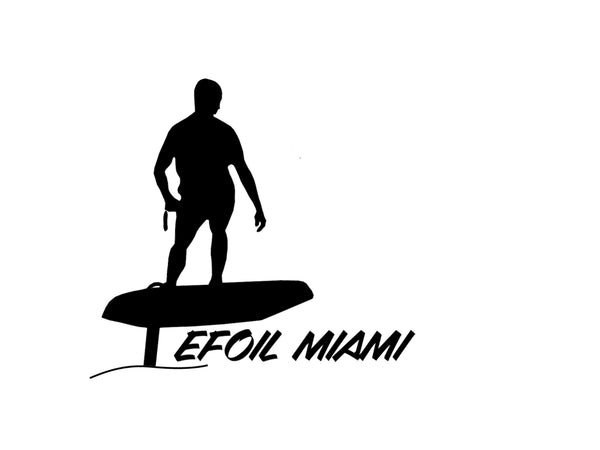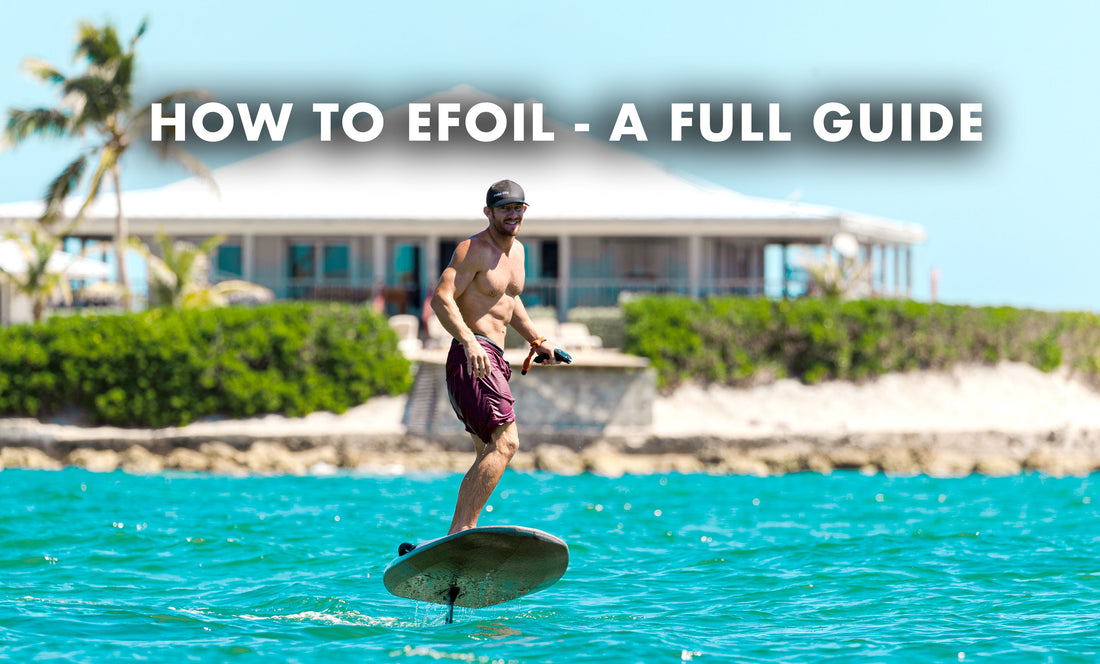In this blog, we'll cover what you need to know about your first time eFoiling.
- Choosing an eFoil location.
- Do I need eFoil saftey equipment?
- How do I carry my eFoil?
- What are the best settings to learn eFoiling?
- How do I ride an eFoil the first time?
- How do I stand up on an eFoil?
- How do I fly on an eFoil?
- Our top beginner eFoil package
Choosing an eFoil location.
Finding a safe location for eFoiling is not just important; it's crucial for your learning process, your safety, and the safety of others. You need a place with deep enough water, minimal boat traffic, calm water, and few swimmers, ensuring your safety and enjoyment.
What water depth do I need for eFoiling?
When scouting for an eFoiling location, look for a body of water that meets specific criteria. The water should be at least 5 feet deep, free of underwater foliage or debris, and ideally without large logs or sudden sandbars. These conditions are essential to protect your hydrofoil wings and to prevent unexpected eFoil dismounts. Underwater plants create drag and clog the eFoil propellor.
Do I need smooth water for eFoiling?
eFoiling is an exhilarating experience that allows you to ride on the lake even when wakeboarders cannot. You can also make the most of any wave or wake, turning bad conditions into fun. However, when starting out, it's best to choose smooth water. Avoid venturing into the ocean with a large shore break or waves. Similarly, a choppy lake with lots of boat wake can pose a challenge for beginners.
Avoid boats and pedestrians when eFoiling.
For safety, do not eFoil near swimmers or surfers. It's also wise to stay out of heavy boat traffic. Obviously, we can all share the lake or river, so this takes some common sense. Avoid boat channels and high-volume areas. Look for a small culdesac on the lake or go at times when there is less traffic. Holiday weekends in the summer can be hectic on the water.
Do I need eFoil Safety equipment?
After you have chosen your eFoil, you will want some safety gear. If you don't know what eFoil is best, check out our blog on the best gear to learn eFoiling.
Investing in eFoil safety equipment is a crucial step after choosing your eFoil. An eFoil Helmet and an impact or flotation vest are highly recommended. At our eFoil lesson center in Miami, we teach on the Waydoo Flyer One Plus with softer EPP foam, minimizing impacts. However, accidents can happen, and a foil is underneath you in the water. A helmet to protect your head and a vest to help float you and protect your body are invaluable investments in your safety.

How do I carry my eFoil to the water?
Transporting your eFoil to the water is a breeze with the Waydoo rolling case. If you don't have one, use the handle provided on the side of most eFoil boards. Hold onto the mast behind your back with your other arm and walk with the eFoil board. We recommend removing the eFoil batteries first to make it easier. Once you reach the water, put the battery back in and get ready to take off!
As you enter the water, you can flip most eFoils upside down to float them on the board with the mast, the vertical part of the foil, in the air. Push the board out into deeper water of about 5 feet. Now roll the board back over and climb up from the side of the board.
What are the best settings to learn eFoiling?
You want to set your Waydoo remote to the lowest possible setting. For the first rides, you won't be worried about getting up to speed and getting on to the foil. If you're not using a Waydoo, most eFoil remotes have a few speed settings. We recommend starting with the lowest setting to build confidence for your first ride.
How do I ride an eFoil for the first time?
Learning to ride an eFoil is an exciting journey. Start by laying on the board in a prone position like a surfer with your head up. Keep your weight forward on the board closer to the nose than the tail. This will prevent the eFoil from accidentally rising on you. Activate your remote and start riding on your belly. This initial drill is designed to help you get used to controlling the board and hydrofoil wings, and it's a fun and constructive way to build your confidence.
Spend at least 15 to 30 minutes with this drill. You can practice turning the board by leaning from side to side and engaging the rail of the board and the wind underneath you. Try going in circles and making sharp turns to get used to the wings you are using.
Repeat this drill on your knees, facing forward like a skier. Set the remote for a slightly higher speed to get used to balancing on the board. This is an essential skill for learning how to pop up later. Again, practice making lots of turns by applying pressure with one knee or the other. Feel how the board turns and how much pressure it takes to make a sharp or mild turn.
How do I stand up on an eFoil?
After 30 minutes of practice, you can start the 'taxi stage '. This is when you practice popping up and riding the board on the water without taking flight. To pop up, ride on your knees and place one hand on the front of the board. Get the board going with a bit of speed and apply pressure to your front hand. Slide one foot next to your hand and rise into a standing position. One foot near the nose and one foot over the mast. Your legs should be shoulder width apart with your weight over your front foot.
As before, you will be riding at a slow speed while standing up on the eFoil board. Now, you can use your heels and toes to practice turning. Take small turns at first and work into larger turns. As you get comfortable, you may use a faster speed on the eFoil remote. Be careful not to go too fast; the board will want to rise onto the foil at 11 miles per hour.
How do I get up on an eFoil?
It's time for your first flight when you are comfortable turning the board and riding on the water. Speed is your friend here, so the best two tips we can give are to keep your weight forward and get comfortable riding the board at 11 miles per hour on the water first. If you go too slow, the board will pop the nose up and drag at an angle, making it very awkward to recover from.
Our top pick beginner eFoil Package
At eFoil Miami, we teach eFoil lessons on the Waydoo Flyer One Plus EPP paired with the explorer 240 hydrofoil wing and sometimes with the Waydoo Flyerpod. This is our favorite eFoil to for new riders. At 110 liters, it's large enough to learn without being cumbersome. The flyer pod and large wing make the board incredibly stable and easy for the first flights. The EPP foam makes the Waydoo light and easy to carry and its softer if you do take a fall.


